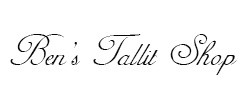Let me begin by saying that in general I'm partial to Mishkan Hatchelet, since I work closely with one of their distributors (a second-generation Mishkan Hatchelet distributor!) and because most of the classic wool tallitot we sell are made by Mishkan Hatchelet (with a few exceptions).
Talitnia & Mishkan Hatchelet: Neck and neck
In Israel the top two traditional wool tallit makers are Talitnia and Mishkan Hatchelet (Keter). When one of them comes out with a new type of tallit, the other comes out with an imitation. Last week I was in one of the leading tallit stores in Jerusalem. They sell both Talitnia and Mishkan Hatchelet, so I asked them how the two traditional tallit makers compare.
The seller I spoke with – a tallit industry veteran – claimed that as a general rule, Talitnia is stronger and Mishkan has better finishing work. Whether that's accurate I can't say. Another tallit industry professional told me that if you buy a standard traditional tallit, the Prima A.A. made by Mishkan Hatchelet has a tighter weave than the Talitnia counterpart. My understanding is that in general the difference in quality between the two companies is insignificant.
Traditional Tallit: Chatanim, Tallit Hamefoar, Prima A.A.
As long as I've mentioned the Prima A.A. Tallit, let me add a few words to help out many of my customers who are bewildered by the traditional tallit selection we offer. If you want to buy a traditional wool tallit, with black stripes (or white with white stripes), they may all look the same online. But the truth is that even if you were browsing a tallit shop and looking at the tallitot up close and personal, many of them would still look very much alike.
When you go up from Prima A.A. to Chatanim (a.k.a. Klilas Yofi) you're paying for not so much for a thicker tallit, but for a denser tallit, i.e. a denser weave. That makes it likely to last longer and it will hang a big straighter. The Chatanim Tallit also has a few added features: stiffened corners to keep the tzitzit from sliding around the corner (they are supposed to stay on the side with the fringe), stain resistant fabric, and fabric treated to stay white over time. The atara and the striping on Mishkan Hatchelet's Prima A.A. Tallit and the Chatanim Tallit are identical.
The Prima A.A. really is a good tallit, but if you want a no-compromise traditional tallit for a bar mitzvah boy, a chassan – or yourself – the Chatanim is the way to go.
For those looking for a non-slip tallit, Mishkan Hatchelet has two models: Hamefoar ("Pe'er" in Hebrew) and Tashbetz. The Tashbetz is the non-slip equivalent of the Prima A.A. and Hamefoar is the non-slip parallel to the Chatanim. Mishkan Hatchelet's Tashbetz Tallit is made of a lightweight fabric and if you look at it up close you will notice it features a box-like weave to keep the tallit in place; Hamefoar is also textured, but less than the Tashbetz.
 United States Dollar
United States Dollar
 Shekel
Shekel
 Euro
Euro
 British Pound
British Pound
 Australian Dollar
Australian Dollar
 New Zealand Dollar
New Zealand Dollar
 Canadian Dollar
Canadian Dollar
